一、管理数据库连接 1、使用配置文件管理连接之约定 在数据库上下文类中,如果我们只继承了无参数的DbContext,并且在配置文件中创建了和数据库上下文类同名的连接字符串,那么EF会
在数据库上下文类中,如果我们只继承了无参数的DbContext,并且在配置文件中创建了和数据库上下文类同名的连接字符串,那么EF会使用该连接字符串自动计算出数据库的位置和数据库名。比如,我们的数据库上下文定义如下:
using System;
using System.Collections.Generic;
using System.Data.Entity;
using System.Linq;
using System.Text;
using System.Threading.Tasks;
namespace ConventionConfigure.EF
{
/// <summary>
/// 继承无参数的DbContext
/// </summary>
public class SampleDbEntities :DbContext
{
public SampleDbEntities()
{
// 数据库不存在时创建数据库
Database.CreateIfNotExists();
}
}
}在配置文件中定义的连接字符串如下:
<connectionStrings>
<add name="SampleDbEntities" connectionString="Data Source=.;Initial Catalog=TestDb;Integrated Security=True;MultipleActiveResultSets=True" providerName="System.Data.sqlClient" />
</connectionStrings>定义的连接字符串中name的value值和创建的数据库上下文类的类名相同,这样EF会使用该连接字符串执行数据库操作,究竟会发生什么呢?
运行程序,Program类定义如下:
using ConventionConfigure.EF;
using System;
using System.Collections.Generic;
using System.Linq;
using System.Text;
using System.Threading.Tasks;
namespace ConventionConfigure
{
class Program
{
static void Main(string[] args)
{
using (var context = new SampleDbEntities())
{ }
Console.WriteLine("创建成功");
Console.ReadKey();
}
}
}当运行应用程序时,EF会寻找我们的数据库上下文类,即“SampleDbEntities”,并在配置文件中寻找和它同名的连接字符串,然后它会使用该连接字符串计算出应该使用哪个数据库provider,之后检查数据库位置,之后会在指定的位置创建一个名为TestDb.mdf的数据库文件,同时根据连接字符串的Initial Catalog属性创建了一个名为TestDb的数据库。创建的数据库结构如下:
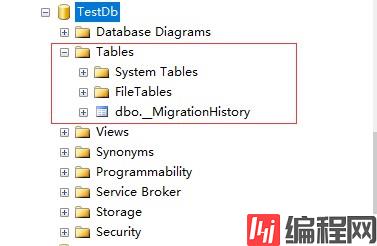
查看创建后的数据库,会发现只有一张迁移记录表。
如果我们已经有了一个定义数据库位置和名称的ConnectionString,并且我们想在数据库上下文类中使用这个连接字符串,连接字符串如下:
<connectionStrings>
<add name="AppConnection" connectionString="Data Source=.;Initial Catalog=TestDb;Integrated Security=True;MultipleActiveResultSets=True" providerName="System.Data.SqlClient" />
</connectionStrings>以上面创建的数据库TestDb作为已经存在的数据库,新添加实体类Student,使用已经存在的ConnectionString查询数据库的Student表,Student实体类定义如下:
using System;
using System.Collections.Generic;
using System.ComponentModel.DataAnnotations.Schema;
using System.Linq;
using System.Text;
using System.Threading.Tasks;
namespace ExistsConnectionString.Model
{
[Table("Student")]
public class Student
{
public int Id { get; set; }
public string Name { get; set; }
public string Sex { get; set; }
public int Age { get; set; }
}
}我们将该连接字符串的名字传入数据库上下文DbContext的有参构造函数中,数据库上下文类定义如下:
using ExistsConnectionString.Model;
using System;
using System.Collections.Generic;
using System.Data.Entity;
using System.Linq;
using System.Text;
using System.Threading.Tasks;
namespace ExistsConnectionString.EF
{
public class SampleDbEntities : DbContext
{
public SampleDbEntities()
: base("name=AppConnection")
{
}
// 添加到数据上下文中
public virtual DbSet<Student> Students { get; set; }
}
}上面的代码将连接字符串的名字传给了DbContext类的有参构造函数,这样一来,我们的数据库上下文就会开始使用该连接字符串了,在Program类中输出Name和Age字段的值:
using ExistsConnectionString.EF;
using System;
using System.Collections.Generic;
using System.Linq;
using System.Text;
using System.Threading.Tasks;
namespace ExistsConnectionString
{
class Program
{
static void Main(string[] args)
{
using (var context = new SampleDbEntities())
{
foreach (var item in context.Students)
{
Console.WriteLine("姓名:"+item.Name+" "+"年龄:"+item.Age);
}
}
}
}
}运行程序,发现会报下面的错误:
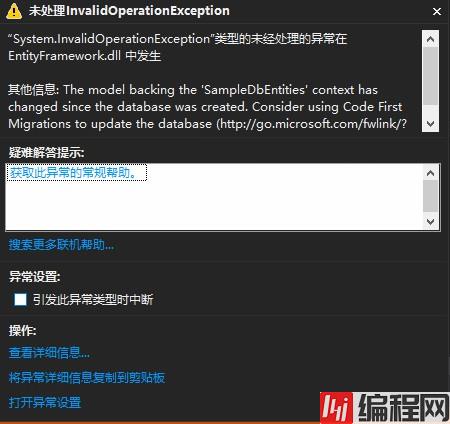
出现上面报错的原因是因为数据库上下文发生了改变,与现有数据库不匹配。解决方案:
重新运行程序,结果如下:
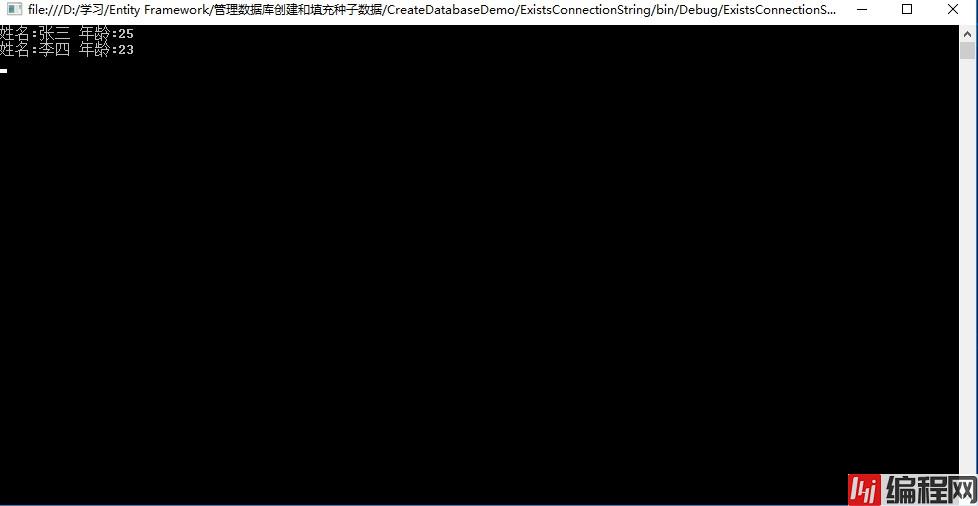
注意:如果在配置文件中还有一个和数据库上下文类名同名的ConnectionString,那么就会使用这个同名的连接字符串。无论我们对传入的连接字符串名称如何改变,都是无济于事的,也就是说和数据库上下文类名同名的连接字符串优先权更大。(即约定大于配置)
通常在一些老项目中,我们只会在项目中的某个部分使用EF Code First,同时,我们想对数据上下文类使用已经存在的数据库连接,如果要实现这个,可将连接对象传给DbContext类的构造函数,数据上下文定义如下:
using ExistsDbConnection.Model;
using System;
using System.Collections.Generic;
using System.Data.Common;
using System.Data.Entity;
using System.Linq;
using System.Text;
using System.Threading.Tasks;
namespace ExistsDbConnection.EF
{
public class SampleDbEntities :DbContext
{
public SampleDbEntities(DbConnection con)
: base(con, contextOwnsConnection: false)
{
}
public virtual DbSet<Student> Students { get; set; }
}
}这里要注意一下contextOwnsConnection参数,之所以将它作为false传入到上下文,是因为它是从外部传入的,当上下文超出了范围时,可能会有人想要使用该连接。如果传入true的话,那么一旦上下文出了范围,数据库连接就会立即关闭。
Program类定义如下:
using System;
using System.Collections.Generic;
using System.Data.Common;
using System.Data.SqlClient;
using System.Linq;
using System.Text;
using System.Threading.Tasks;
using System.Configuration;
using ExistsDbConnection.EF;
namespace ExistsDbConnection
{
class Program
{
static void Main(string[] args)
{
// 读取连接字符串
string conn = ConfigurationManager.ConnectionStrings["AppConnection"].ConnectionString;
// DbConnection是抽象类,不能直接实例化,声明子类指向父类对象
DbConnection con = new SqlConnection(conn);
using (var context = new SampleDbEntities(con))
{
foreach (var item in context.Students)
{
Console.WriteLine("姓名:" + item.Name + " " + "年龄:" + item.Age);
}
}
Console.WriteLine("读取完成");
Console.ReadKey();
}
}
}运行程序,结果如下:

首次运行EF Code First应用时,EF会做下面的这些事情:
1、检查正在使用的DbContext类。
2、找到该上下文类使用的connectionString。
3、找到领域实体并提取模式相关的信息。
4、创建数据库。
5、将数据插入系统。
一旦模式信息提取出来,EF会使用数据库初始化器将该模式信息推送给数据库。数据库初始化器有很多可能的策略,EF默认的策略是如果数据库不存在,那么就重新创建;如果存在的话就使用当前存在的数据库。当然,我们有时也可能需要覆盖默认的策略,可能用到的数据库初始化策略如下:
CreateDatabaseIfNotExists:CreateDatabaseIfNotExists:顾名思义,如果数据库不存在,那么就重新创建,否则就使用现有的数据库。如果从领域模型中提取到的模式信息和实际的数据库模式不匹配,那么就会抛出异常。
DropCreateDatabaseAlways:如果使用了该策略,那么每次运行程序时,数据库都会被销毁。这在开发周期的早期阶段通常很有用(比如设计领域实体时),从单元测试的角度也很有用。
DropCreateDatabaseIfModelChanges:这个策略的意思就是说,如果领域模型发生了变化(具体而言,从领域实体提取出来的模式信息和实际的数据库模式信息失配时),就会销毁以前的数据库(如果存在的话),并创建新的数据库。
MigrateDatabaseToLatestVersion:如果使用了该初始化器,那么无论什么时候更新实体模型,EF都会自动地更新数据库模式。这里很重要的一点是:这种策略更新数据库模式不会丢失数据,或者是在已有的数据库中更新已存在的数据库对象。MigrateDatabaseToLatestVersion初始化器只有从EF4.3才可用。
EF默认使用CreateDatabaseIfNotExists作为默认初始化器,如果要覆盖这个策略,那么需要在DbContext类中的构造函数中使用Database.SetInitializer方法,下面的例子使用DropCreateDatabaseIfModelChanges策略覆盖默认的策略。数据库上下文类定义如下:
using InitializationStrategy.Model;
using System;
using System.Collections.Generic;
using System.Data.Entity;
using System.Linq;
using System.Text;
using System.Threading.Tasks;
namespace InitializationStrategy.EF
{
public class SampleDbEntities : DbContext
{
public SampleDbEntities()
: base("name=AppConnection")
{
// 使用DropCreateDatabaseIfModelChanges策略覆盖默认的策略
Database.SetInitializer<SampleDbEntities>(new DropCreateDatabaseIfModelChanges<SampleDbEntities>());
}
// 添加到数据上下文中
public virtual DbSet<Student> Students { get; set; }
}
}这样一来,无论什么时候创建上下文类,Database.SetInitializer()方法都会被调用,并且将数据库初始化策略设置为DropCreateDatabaseIfModelChanges。
Student领域实体类新增加Email和Address两个属性:
using System;
using System.Collections.Generic;
using System.ComponentModel.DataAnnotations.Schema;
using System.Linq;
using System.Text;
using System.Threading.Tasks;
namespace InitializationStrategy.Model
{
[Table("Student")]
public class Student
{
public int Id { get; set; }
public string Name { get; set; }
public string Sex { get; set; }
public int Age { get; set; }
public string Email { get; set; }
public string Address { get; set; }
}
}Program类定义如下:
using InitializationStrategy.EF;
using System;
using System.Collections.Generic;
using System.Linq;
using System.Text;
using System.Threading.Tasks;
namespace InitializationStrategy
{
class Program
{
static void Main(string[] args)
{
using (var context = new SampleDbEntities())
{
foreach (var item in context.Students)
{
}
}
Console.WriteLine("创建成功");
Console.ReadKey();
}
}
}运行程序后,数据库表结构如下:
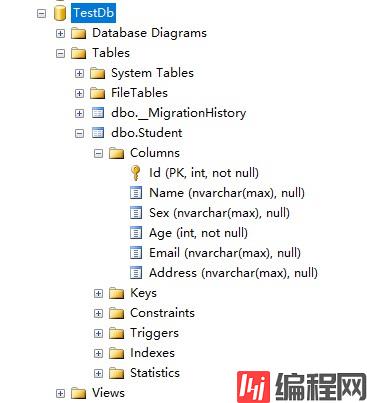
注意:如果处于生产环境,那么我们肯定不想丢失已经存在的数据。这时我们就需要关闭该初始化器,只需要将null传给Database.SetInitlalizer()方法,如下所示:
public SampleDbEntities(): base("name=AppConnection")
{
Database.SetInitializer<SampleDbEntities>(null);
}到目前为止,无论我们选择哪种策略初始化数据库,生成的数据库都是一个空的数据库。但是许多情况下我们总想在数据库创建之后、首次使用之前就插入一些数据。此外,开发阶段可能想以admin的资格为其填充一些数据,或者为了测试应用在特定的场景中表现如何,想要伪造一些数据。
当我们使用DropCreateDatabaseAlways和DropCreateDatabaseIfModelChanges初始化策略时,插入种子数据非常重要,因为每次运行应用时,数据库都要重新创建,每次数据库创建之后在手动插入数据非常乏味。接下来我们看一下当数据库创建之后如何使用EF来插入种子数据。
为了向数据库插入一些初始化数据,我们需要创建满足下列条件的数据库初始化器类:
1、从已存在的数据库初始化器类中派生数据。
2、在数据库创建期间种子化。
下面演示如何初始化种子数据
using System;
using System.Collections.Generic;
using System.ComponentModel.DataAnnotations.Schema;
using System.Linq;
using System.Text;
using System.Threading.Tasks;
namespace InitializationSeed.Model
{
[Table("Employee")]
public class Employee
{
public int EmployeeId { get; set; }
public string FirstName { get; set; }
public string LastName { get; set; }
}
}使用EF的Code First方式对上面的模型创建数据库上下文:
public class SampleDbEntities : DbContext
{
public virtual DbSet<Employee> Employees { get; set; }
}假设我们使用的是DropCreateDatabaseAlways数据库初始化策略,那么初始化器类就要从该泛型类继承,并传入数据库上下文作为类型参数。接下来,要种子化数据库就要重写DropCreateDatabaseAlways类的Seed()方法,而Seed()方法拿到了数据库上下文,因此我们可以使用它来将数据插入数据库:
using InitializationSeed.Model;
using System;
using System.Collections.Generic;
using System.Data.Entity;
using System.Linq;
using System.Text;
using System.Threading.Tasks;
namespace InitializationSeed.EF
{
/// <summary>
/// 数据库初始化器类
/// </summary>
public class SeedingDataInitializer : DropCreateDatabaseAlways<SampleDbEntities>
{
/// <summary>
/// 重写DropCreateDatabaseAlways的Seed方法
/// </summary>
/// <param name="context"></param>
protected override void Seed(SampleDbEntities context)
{
for (int i = 0; i < 6; i++)
{
var employee = new Employee
{
FirstName="测试"+(i+1),
LastName="工程师"
};
context.Employees.Add(employee);
}
base.Seed(context);
}
}
}上面的代码通过for循环创建了6个Employee对象,并将它们添加给数据库上下文类的Employees集合属性。这里值得注意的是我们并没有调用DbContext.SaveChanges()方法,因为它会在基类中自动调用。
using InitializationSeed.Model;
using System;
using System.Collections.Generic;
using System.Data.Entity;
using System.Linq;
using System.Text;
using System.Threading.Tasks;
namespace InitializationSeed.EF
{
public class SampleDbEntities :DbContext
{
public SampleDbEntities()
: base("name=AppConnection")
{
// 类型传SeedingDataInitializer
Database.SetInitializer<SampleDbEntities>(new SeedingDataInitializer());
}
// 领域实体添加到数据上下文中
public virtual DbSet<Employee> Employees { get; set; }
}
}using InitializationSeed.EF;
using System;
using System.Collections.Generic;
using System.Linq;
using System.Text;
using System.Threading.Tasks;
namespace InitializationSeed
{
class Program
{
static void Main(string[] args)
{
using (var context = new SampleDbEntities())
{
foreach (var item in context.Employees)
{
Console.WriteLine("FirstName:"+item.FirstName+" "+"LastName:"+item.LastName);
}
}
Console.WriteLine("读取完成");
Console.ReadKey();
}
}
}
查看数据库
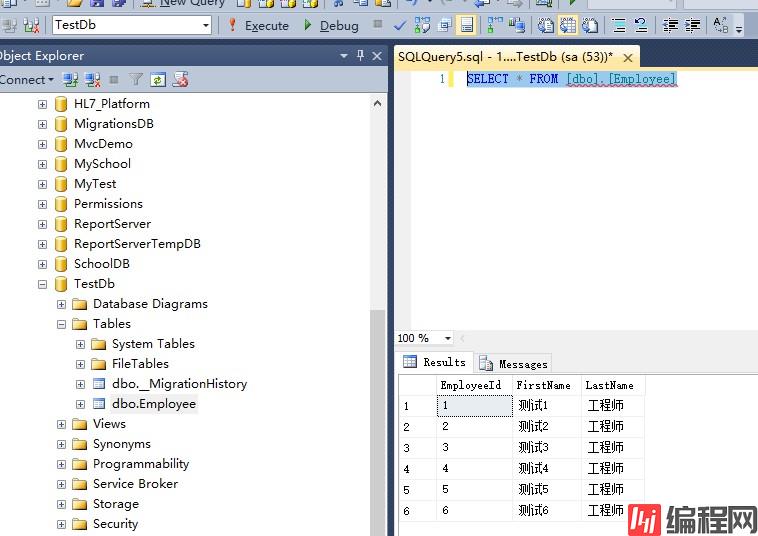
种子数据填充完成。
使用数据迁移的方式会生成Configuration类,Configuration类定义如下:
namespace DataMigration.Migrations
{
using System;
using System.Data.Entity;
using System.Data.Entity.Migrations;
using System.Linq;
internal sealed class Configuration : DbMigrationsConfiguration<DataMigration.SampleDbEntities>
{
public Configuration()
{
AutomaticMigrationsEnabled = false;
}
protected override void Seed(DataMigration.SampleDbEntities context)
{
// This method will be called after migrating to the latest version.
// You can use the DbSet<T>.AddOrUpdate() helper extension method
// to avoid creating duplicate seed data.
}
}
}重写Configuration类的Seed()方法也可以实现插入种子数据,重写Seed()方法:
namespace DataMigration.Migrations
{
using DataMigration.Model;
using System;
using System.Data.Entity;
using System.Data.Entity.Migrations;
using System.Linq;
internal sealed class Configuration : DbMigrationsConfiguration<DataMigration.SampleDbEntities>
{
public Configuration()
{
AutomaticMigrationsEnabled = false;
}
protected override void Seed(DataMigration.SampleDbEntities context)
{
// This method will be called after migrating to the latest version.
// You can use the DbSet<T>.AddOrUpdate() helper extension method
// to avoid creating duplicate seed data.
context.Employees.AddOrUpdate(
new Employee { FirstName = "测试1", LastName = "工程师" },
new Employee { FirstName = "测试2", LastName = "工程师" }
);
}
}
}使用数据迁移,然后查看数据库结果:
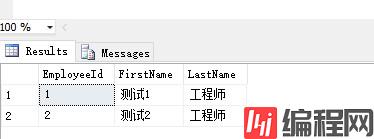
发现使用数据迁移的方式也将种子数据插入到了数据库中。
代码下载地址:点此下载
到此这篇关于Entity Framework使用Code First模式管理数据库的文章就介绍到这了。希望对大家的学习有所帮助,也希望大家多多支持编程网。
--结束END--
本文标题: EntityFramework使用CodeFirst模式管理数据库
本文链接: https://www.lsjlt.com/news/141407.html(转载时请注明来源链接)
有问题或投稿请发送至: 邮箱/279061341@qq.com QQ/279061341
下载Word文档到电脑,方便收藏和打印~
2023-05-21
2023-05-21
2023-05-21
2023-05-21
2023-05-20
2023-05-20
2023-05-20
2023-05-20
2023-05-20
2023-05-20
回答
回答
回答
回答
回答
回答
回答
回答
回答
回答
0